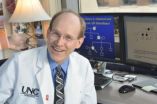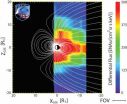(Press-News.org) CHAPEL HILL, N.C. - In the ten years since the human genetic code was mapped, expectations among scientists, health care industry, policy makers, and the public have remained high concerning the promise of genomics research for improving health.
But a new commentary by four internationally prominent genetic medicine and bioethics experts cautions against the dangers of inflated expectations – an unsustainable genomic bubble – and it offers ways to avoid it while still realizing "the true – and considerable – promise of the genomic revolution."
"This commentary is an attempt to bring some balance to the hopes and claims that swirl around the issue of genomic medicine. It is a cautionary essay that tries to extol the real and formidable potential of genomic medicine but also attempts to counter what we see as exaggerated claims, said lead author medical geneticist James P. Evans, MD, PhD, Bryson Distinguished Professor of Genetics and Medicine at the University of North Carolina at Chapel Hill and the UNC Lineberger Comprehensive Cancer Center.
"Our fear is that if we are uncritical and naïve in our enthusiasm for these exciting technologies we risk both diversion of precious resources and premature implementation which could hurt patients - as well as a backlash which will hurt our field," Evans warns.
The commentary appears in the February 18, 2011 issue of the journal Science. Co-authors with Evans are Eric M. Meslin, PhD, director, Center for Bioethics, Indiana University, Indianapolis; Theresa M. Marteau, PhD, FMedSci, professor of health psychology, Kings College, London, UK; and Timothy Caulfield, LL.M., F.R.S.C., Canada Research Chair in Health Law & Policy, University of Alberta, Edmonton, Alberta.
"Breathtaking" is how the authors describe the progress already made in genomic research. But, they caution, the considerable promise of genomics must be evaluated through a realistic lens. Advances in individualized medicine, or pharmacogenetics for example, still require the importance of human behavior in health outcomes: the most powerful predictor of a drug's efficacy depends less on genetics than whether the patient takes the drug.
Among the reasons they cite making genomics the persistent recipient of "hyperbole" and inflated expectations, some are tied to impatience for practical applications, market forces and unbridled (but uncritical) enthusiasm. The news media also is named for "playing an obvious role in the creation of unrealistic hopes."
"These forces act together to produce a kind of "cycle of hype" that drive overly optimistic representations of the research," said co-author Timothy Caulfield.
In their short-list of recommendations for avoiding inflation of the "genomic bubble, Evans and co-authors offer the following: (1) reevaluate funding priorities to stress behavioral and social science research aimed at behavior change for improving health; (2) foster a realistic understanding "of the incremental nature of science and the need for statistical rigor," within the scientific community and that the media make more responsible claims for genomic research; (3) maintain a focus on developing high-quality evidence before integrating good ideas into medical practice.
"By highlighting the risks of continuing to promise results from genomic science, we were hoping to draw attention to a more sustainable approach to reaping the benefits from genomic science," said co-author Eric Meslin.
The authors assert their belief that the current age of genomics will provide great benefits to human health "Ours is not a call to gut existing research or too-rigidly tie funding to degree of disease burden … The pursuit of our common goal – improved human health – demands that we take a hard look at disease causation and order our priorities accordingly."
INFORMATION:
Promise of genomics research needs a realistic view
2011-02-18
ELSE PRESS RELEASES FROM THIS DATE:
Technology breakthrough fuels laptops and phones, recharges scientist's 60-year career
2011-02-18
EAST LANSING, Mich. — How does a scientist fuel his enthusiasm for chemistry after 60 years?
By discovering a new energy source, of course.
This week, SiGNa Chemistry Inc. unveiled its new hydrogen cartridges, which provide energy to fuel cells designed to recharge cell phones, laptops and GPS units. The green power source is geared toward outdoor enthusiasts as well as residents of the Third World, where electricity in homes is considered a luxury.
"SiGNa has created an inherently-safe solution to produce electric power, resulting in an eco-friendly and cost-effective ...
Asthma tied to bacterial communities in the airway
2011-02-18
Asthma may have a surprising relationship with the composition of the species of bacteria that inhabit bronchial airways, a finding that could suggest new treatment or even potential cures for the common inflammatory disease, according to a new UCSF-led study.
Using new detection methods, researchers learned that the diversity of microbes inside the respiratory tract is far vaster than previously suspected – creating a complex and inter-connected microbial neighborhood that appears to be associated with asthma, and akin to what has also been found in inflammatory bowel ...
Mayo researchers, Rochester educators, students to present at science conference
2011-02-18
ROCHESTER, Minn. -- America's largest general science conference will be the setting next week for seven presentations on how zebrafish changed the classroom in Rochester. Those presenting at the conference in Washington, D.C., include researchers from Mayo Clinic and Winona State University, educators from the Rochester school system, and several students.
"We started out trying to improve how science was taught. That led to adding curriculum beyond science, and resulted in improvement in testing and grade outcomes, and now to the experience of reporting all of it at ...
Inexpensive rinsing effective at reducing post-op infection following joint replacement surgery
2011-02-18
CHICAGO – A rinsing technique with betadine that costs just a little over one dollar per patient may significantly reduce the infection rate following total knee and hip joint replacement surgery according to a study by researchers at Rush University Medical Center.
The study, presented at the American Association of Orthopedic Surgeons 2011 Annual Meeting, found that a three minute diluted betadine lavage combined with painting of the skin with a 10% betadine solution prior to surgical closure nearly eliminated early deep post-operative infection.
Deep periprosthetic ...
Canadian brainpower at AAAS in Washington
2011-02-18
Washington (February 17) — Three leading Canadian language and speech experts will take centre stage in discussions on the latest developments in speech research at this year's annual meeting of the American Association for the Advancement of Science in Washington, D.C. (February 17-21).
Ellen Bialystok of York University has been a driving force in revealing the unique window that bilingualism opens on brain function. Her research disproves earlier claims of cognitive deficits among bilingual children, discovering, instead, that bilingual children and adults have distinct ...
ASTRO publishes palliative radiotherapy for bone metastases guideline
2011-02-18
The American Society for Radiation Oncology (ASTRO) Clinical Affairs and Quality Committee has developed a guideline for the use of radiation therapy in treating bone metastases. The guideline will be published in the International Journal of Radiation Oncology•Biology•Physics, an official journal of ASTRO.
Bone metastases are caused when a malignant tumor spreads to the bone. They can lead to debilitating effects including pain, fractures and paralysis due to spinal cord compression. The care of these patients requires collaboration between several types of cancer treatment ...
Catching space weather in the act
2011-02-18
Close to the globe, Earth's magnetic field wraps around the planet like a gigantic spherical web, curving in to touch Earth at the poles. But this isn't true as you get further from the planet. As you move to the high altitudes where satellites fly, nothing about that field is so simple. Instead, the large region enclosed by Earth's magnetic field, known as the magnetosphere, looks like a long, sideways jellyfish with its round bulb facing the sun and a long tail extending away from the sun.
In the center of that magnetic tail lies the plasma sheet. Here, strange things ...
NASA sees former Tropical Storm Carlos still a soaker in the Northern Territory
2011-02-18
Now a remnant low pressure area, former Tropical Storm Carlos continues to move southwest inland over Australia's Northern Territory and dump heavy amounts of rainfall. NASA's Aqua satellite saw some of the high thunderstorms within Carlos over land and extending north into the Timor Sea.
The Atmospheric Infrared Sounder (AIRS) instrument onboard NASA's Aqua satellite measures cloud-top, sea surface and land temperatures. Those are important factors in determining the strength and power of a tropical cyclone. Sea surface temperatures need to be at least as warm 26.6 ...
NASA infrared satellite data see an intensifying Tropical Storm Dianne
2011-02-18
Infrared satellite data from NASA's Aqua satellite reveal that Tropical Storm Dianne is getting organized off the coast of Western Australia today.
NASA's Atmospheric Infrared Sounder (AIRS) infrared imagery suggests that Dianne's center of circulation is consolidating and getting organized. There are bands of thunderstorms wrapping into the center of the storm, indicating strengthening is occurring. The AIRS instrument flies aboard NASA's Aqua satellite. The AIRS infrared image of Tropical Storm Dianne from Feb. 17 at 06:05 UTC (1:05 a.m. EST) showed a large area of ...
To increase physical activity, focus on how, not why
2011-02-18
COLUMBIA, Mo. – Most people know that exercise is important to maintain and improve health; however, sedentary lifestyles and obesity rates are at all-time highs and have become major national issues. In a new study, University of Missouri researchers found that healthy adults who received interventions focused on behavior-changing strategies significantly increased their physical activity levels. Conversely, interventions based on cognitive approaches, which try to change knowledge and attitudes, did not improve physical activity.
"The focus needs to shift from increasing ...




